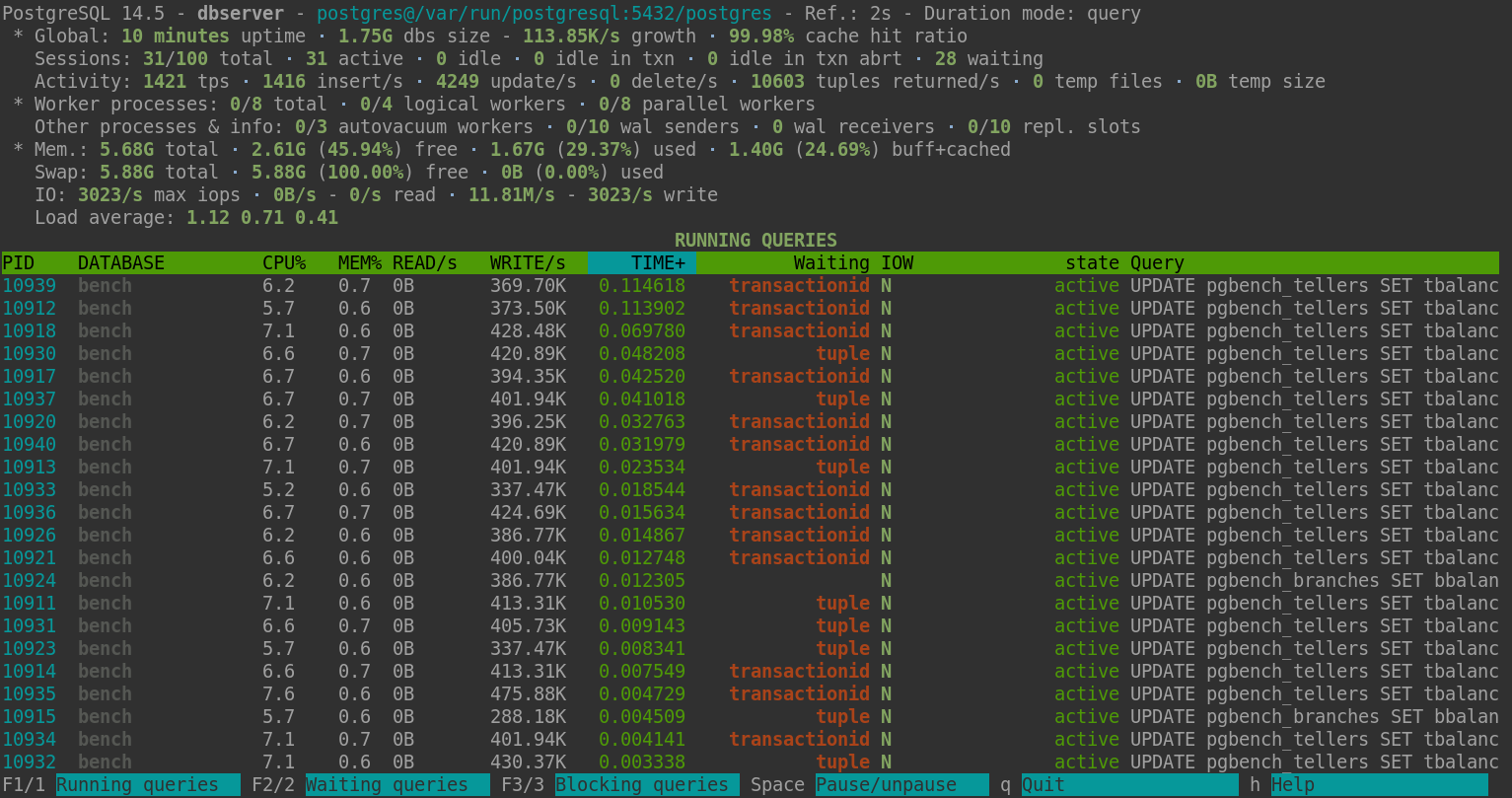Command line tool for PostgreSQL server activity monitoring.
Project description
Command line tool for PostgreSQL server activity monitoring.
Installation
pg_activity requires Python 3.6 or later. It can be installed using pip
(available, e.g., as apt install python3-pip on Debian-based distributions):
$ python3 -m pip install pg_activity psycopg2-binary
or directly from your Linux distribution, if available, e.g.:
$ sudo apt install pg-activity
Usage
pg_activity works localy or remotely. In local execution context, to obtain
sufficient rights to display system informations, the system user running
pg_activity must be the same user running postgresql server (postgres by
default), or have more rights like root. Otherwise, pg_activity can fallback
to a degraded mode without displaying system informations. On the same way,
PostgreSQL user used to connect to the database must be super-user.
ex:
sudo -u postgres pg_activity -U postgres
Options
pg_activity [options]
Options:
--version Show program's version number and exit
-U USERNAME, --username=USERNAME
Database user name (default: "postgres").
-p PORT, --port=PORT Database server port (default: "5432").
-h HOSTNAME, --host=HOSTNAME
Database server host or socket directory (default:
"localhost").
-d DBNAME, --dbname=DBNAME
Database name to connect to (default: "postgres").
--blocksize=BLOCKSIZE Filesystem blocksize (default: 4096).
--rds Enable support for AWS RDS.
--output=FILEPATH Store running queries as CSV.
--help Show this help message and exit.
--debug Enable debug mode for traceback tracking.
--no-db-size Skip total size of DB.
--min-duration Don't display queries with smaller than specified
duration (in seconds).
--verbose-mode=VERBOSE_MODE
Queries display mode. Values: 1-TRUNCATED,
2-FULL(default), 3-INDENTED
--duration-mode=DURATION_MODE
Duration mode. Values: 1-QUERY(default),
2-TRANSACTION, 3-BACKEND
Display options, you can exclude some columns by using them :
--no-database Disable DATABASE.
--no-user Disable USER.
--no-client Disable CLIENT.
--no-cpu Disable CPU%.
--no-mem Disable MEM%.
--no-read Disable READ/s.
--no-write Disable WRITE/s.
--no-time Disable TIME+.
--no-wait Disable W.
--no-app-name Disable App.
Notes
Length of SQL query text that pg_activity reports relies on PostgreSQL
parameter track_activity_query_size. Default value is 1024 (expressed in
bytes). If your SQL query text look truncated, you should increase
track_activity_query_size.
Interactives commands
| Key | Action |
|---|---|
r |
Sort by READ/s, descending |
w |
Sort by WRITE/s, descending |
c |
Sort by CPU%, descending |
m |
Sort by MEM%, descending |
t |
Sort by TIME+, descending |
T |
Change duration mode: query, transaction, backend |
Space |
Pause on/off |
v |
Change queries display mode: full, indented, truncated |
UP/DOWN |
Scroll processes list |
k/j |
Scroll processes list |
q |
Quit |
+ |
Increase refresh time. Maximum value : 5s |
- |
Decrease refresh time. Minimum Value : 0.5s |
F1/1 |
Running queries list |
F2/2 |
Waiting queries list |
F3/3 |
Blocking queries list |
h |
Help page |
R |
Refresh |
D |
Refresh Database Size (including when --no-dbzise option applied) |
Navigation mode
| Key | Action |
|---|---|
UP/k |
Move up the cursor |
DOWN/j |
Move down the cursor |
K |
Terminate the current backend/tagged backends |
C |
Cancel the current backend/tagged backends |
Space |
Tag or untag the process |
q |
Quit |
Other |
Back to activity |
Screenshot
FAQ
I can't see my queries only TPS is shown
pg_activity scans the view pg_stat_activity with a user defined refresh
time comprised between O.5 and 5 seconds. It can be modified in the interface
with the + and - keys. Any query executed between two scans won't be
displayed.
What is more, pg_activity uses different queries to get :
- settings from
pg_settings - version info using
version() - queries and number of connections from
pg_stat_activity - locks from
pg_locks - tps from
pg_databaseusingpg_stat_get_db_xact_commit()andpg_stat_get_db_xact_rollback() - and more ( eg :
pg_cancel_backend()andpg_terminate_backend())
Thoses queries cannot be seen in the query tab because all queries issued from
the pg_activity backend are considered as noise and are not displayed . On
the other hand, the transactions used to get the info for pg_activity's
reporting are still accounted for by postgres in pg_stat_get_db_xact_commit()
and pg_stat_get_db_xact_commit(). Therefore pg_activity will display a non
zero TPS even with no activity on the database, and/or no activity displayed on
screen.
Project details
Release history Release notifications | RSS feed
Download files
Download the file for your platform. If you're not sure which to choose, learn more about installing packages.
Source Distribution
Built Distribution
Hashes for pg_activity-2.0.0a2-py3-none-any.whl
| Algorithm | Hash digest | |
|---|---|---|
| SHA256 | 145a0fe1262cdb72d08a5df950b759bcd79bc0e926826b5e189cf403b329c02d |
|
| MD5 | 363d805c2b54dbcbdaa720c77ab4b750 |
|
| BLAKE2b-256 | eeaa1d7775eea836915a7a1c9d387b1d01a57ff0104db00bc774a06bb9e093f2 |

















